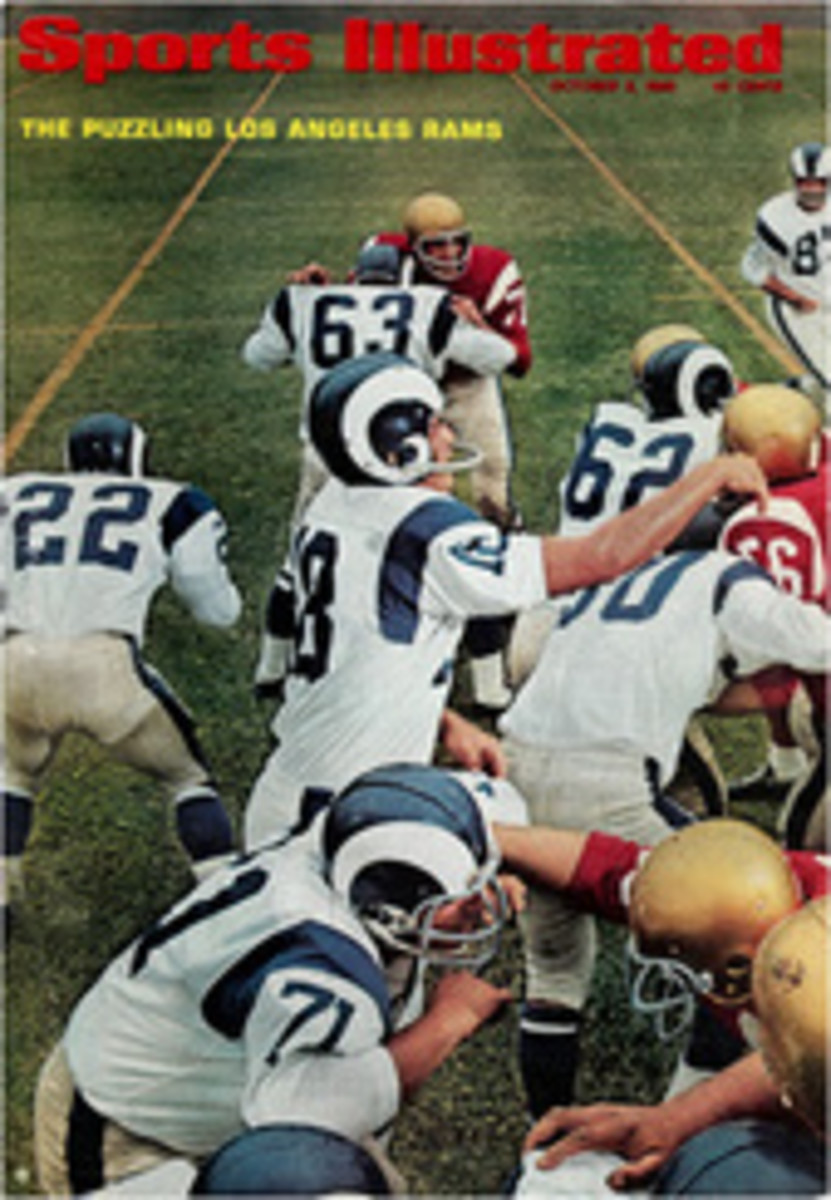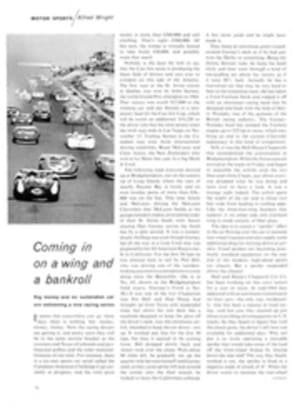
Coming in on a wing and a bankroll
It seems that everywhere you go these days there is nothing but money, money, money. Now the racing drivers are getting it, and pretty soon they will be in the same income bracket as the crooners and Texas oil johnnies and professional golfers and the other multimillionaires of our time. For instance, there is a six-race sports car serial called the Canadian-American Challenge Cup currently in progress, and the total prize money is more than $360,000 and still climbing. That's right—$360,000. Of this sum, the winner is virtually bound to take home $30,000, and possibly twice that much.
Nobody is the least bit loth to say that the Can-Am series is producing the finest field of drivers and cars ever to compete on this side of the Atlantic. The first race at the St. Jovite circuit in Quebec was won by John Surtees, the world Grand Prix champion in 1964. That victory was worth $12,000 to the winning car and put Surtees in a temporary lead for the Can-Am Cup, which will be worth an additional $19,250 to the driver who has the most points when the sixth race ends in Las Vegas on November 13. Trailing Surtees in the Canadian race were those international driving celebrities, Bruce McLaren and Chris Anion, the New Zealanders who won at Le Mans this year in a big Mark II Ford.
The following week everyone showed up at Bridgehampton, out on the eastern tip of Long Island, where the view of nearby Peconic Bay is lovely and an even lovelier purse of more than $36,000 was on the line. This time Anion and McLaren, driving the McLaren Chevrolets that McLaren builds at his garage outside London, reversed the order of their St. Jovite finish, with Anion chasing Dan Gurney across the finish line by a split second. It was a tremendously thrilling race even though Gurney led all the way in a Lola Ford that was prepared by his All American Racers outfit in California. For the first 50 laps he was pressed nose to tail by Phil Hill, who was driving one of the weirdest-looking automotive contraptions to come along since the Batmobile. (He is in No. 65, shown as the Bridgehampton field starts. Gurney's Ford is No. 30.) It was one of the two Chaparrals that Jim Hall and Hap Sharp had brought up from Texas and, suspended three feet above the rear deck like a sunshade designed to keep the glare off the driver's neck, was this enormous airfoil, intended to keep the car down—not up. It worked just fine for the first 50 laps, but then it seemed to be coming loose. Hill dropped slowly back and Anion took over the chase. With about 60 miles left, he gradually ate up the quarter mile between himself and Gurney until, as they came up the hill and around the corner into the final stretch, he looked to have the Californian collared. A few more yards and he might have made it.
They hung an enormous green wreath around Gurney's neck as if he had just won the Derby or something. Being the Jimmy Stewart type, he hung his head shyly and later went through a kind of toe-scuffing act about his victory as if it were 90% luck. Actually he has a marvelous car that may be very hard to beat in the remaining races. He has taken a Ford Fairlane block and topped it off with an aluminum racing head that he designed and built with the help of Harry Weslake, one of the geniuses of the British racing industry. The Gurney-Weslake head has jumped the Fairlane engine up to 525 hp or more, which may bring an end to the current Chevrolet supremacy in this kind of competition.
Still, it was the Hall-Sharp Chaparrals that monopolized the conversation at Bridgehampton. When the Texas caravan arrived at the track on Friday and began to assemble the airfoils atop the two blue-and-white Chaps, just about everyone dropped what he was doing and went over to have a look. It was a strange sight indeed. The airfoil spans the width of the car and is about two feet wide from leading to trailing edge. Like the three-foot-long brackets that support it on either side, this overhead wing is made entirely of fiber glass.
The idea is to create a "spoiler" effect in the air flowing over the car to increase rear-wheel traction and also supply some additional drag for slowing down at corners. Fixed spoilers are becoming practically standard equipment on the rear end of the modern, high-speed sports car chassis. But a spoiler suspended above the chassis!
Hall and Sharp's Chaparral Car Co. has been working on this outré notion for a year or more. In mid-1964 they appeared with an automatic transmission on their cars—the only one, incidentally, that has been a success in road racing—and last year they cleaned up just about everything of consequence on U.S. tracks. So they began to figure that with the clutch gone, the driver's left foot was available for additional duty. Why not put it to work operating a movable spoiler that would take some of the load off the front-wheel brakes by forcing down the rear end? The way they finally worked it out, the spoiler is fixed in a negative angle of attack of 6°. When the driver wants to increase the rear-wheel traction and apply additional drag, he hits a hydraulically operated pedal that will increase the angle to as much as 20°.
The device was not ready in time for St. Jovite, so it had to make its debut at Bridgehampton. Bystanders in the pits were skeptical until the cars took to the track for their qualifying runs on Saturday morning. Jim Hall, driving one of the Chaparrals, ran a few practice laps and then set a new lap record for Bridgehampton at 110.44 mph, giving him the pole position for the race. Hill, who had not had nearly as much experience with the gadget, was somewhat slower in the other car but still managed to qualify in eighth position. But one of the bolts on a supporting strut of the spoiler came loose on Hill's car during a practice run, falling into the bodywork and blowing a tire. Since the car could not be repaired properly overnight, Hill was placed in Hall's car for the race but in his own starting place.
By the end of the first lap Hill had passed everyone ahead of him except Gurney. He hung to Gurney's tail for nearly 150 miles, the spoiler descending as he approached the turns and moving back to the horizontal on the straights. At times he seemed on the verge of passing Gurney, but he never quite made it. Then, with only 20 laps to go, Hill inexplicably began to fall back. Anion and McLaren both passed him in turn, but he clung doggedly to fourth place without any further difficulty, finishing nearly a full minute behind the leaders. Later it turned out that the bolts on the struts had begun to worry him, so he decided to slow down until he could assure himself that there was no danger of the spoiler taking off on its own.
Although it appeared to be a worthwhile innovation, the Chaparral contraption was not without its critics. Some of the drivers complained that it interfered with their vision. Others claimed it was a racing hazard because it might come undone and raise hob with cars to the rear. Bosh, replied Hap Sharp. "They just wish they had it."
As the Can-Am rolled on to Mosport, Ont. last Saturday, the Chaparrals again were the focus of keen interest, Hall qualifying fastest and Hill finishing second in the race itself to Long Island's Mark Donohue (Lola Chevrolet). By next year—who knows?—maybe everybody will have a Texas-style spoiler. Racing fads are like that.

